No podemos controlar el tiempo, pero podemos hacer todo lo posible para reducir los efectos de las bajas temperaturas y la sensación térmica en el ganado.
Efectos del estrés por frío en el ganado
Los meses de invierno en las latitudes septentrionales pueden suponer un importante estrés por frío para ganado. Deben aclimatarse a periodos prolongados de bajas temperaturas y a repentinas ráfagas árticas de frío extremo. Los animales con una buena puntuación de condición corporal (BCS) y acceso al refugio son más capaces de resistir periodos de frío intenso y prolongado.
Durante una ola de frío repentina, la temperatura puede descender por debajo de la "temperatura crítica inferior" (TCI) del animal. La LCT se refiere a la temperatura efectiva a la que debe aumentar la producción de calor corporal y, con lluvia, nieve derretida o viento, puede ser significativamente inferior. Por ejemplo, una temperatura de -7 °C con una velocidad del viento de 48 km/hora equivale a -27 °C (tabla siguiente).


El LCT varía en función de la aclimatación, el peso, la condición y la ingesta energética del ganado. Las vacas lecheras y el ganado de cebo con raciones ricas en grano tienen una LCT muy baja (de -30°C a -45°C) debido a su ingesta de alimentos de alta calidad y a su tasa metabólica. El LCT para vacas de carne preñadas, vacas lecheras secas y terneros en crecimiento, en buena condición corporal, se sitúa entre -10°C y -25°C. Los terneros jóvenes, desde el nacimiento hasta las 3 semanas de edad, tienen una LCT de +13°C. Los terneros lecheros, desde las 3 semanas de edad hasta el destete, tienen un LCT de +1°C.
Con temperaturas más frías y vientos más fuertes, es necesario aumentar las raciones de pienso y los refugios.
SOLUCIÓN IoT: Estación meteorológica IMT 3.3 y previsión meteorológica específica para cada emplazamiento
- Controlar las temperaturas y aumentar la alimentación en respuesta al frío. Proteger a los animales del viento y de las bajas temperaturas, que afectan a las Temperaturas Críticas Inferiores en función del animal.
salud. - Realice un seguimiento en tiempo real de las temperaturas de los cebaderos y de la velocidad y las ráfagas de viento para conocer los efectos de la sensación térmica en la salud del ganado (imagen de la izquierda).
- Conozca las temperaturas previstas, la velocidad del viento y las ráfagas de viento para los próximos 7 días, hora a hora, para conocer las necesidades de ración alimenticia (imagen de la derecha).
- Acceda a los datos y previsiones meteorológicos de los cebaderos en sistemas Android o iOS.


Costes y beneficios
- Supervise las condiciones meteorológicas específicas del cebadero. Observe los valores de temperatura/frío del viento y aumente la alimentación en respuesta al clima frío.
- Proteger a los animales del viento y de los valores elevados de sensación térmica. Los vientos, pueden reducir notablemente la temperatura crítica inferior del ganado, aumentando el estrés por frío en los animales, reduciendo su peso y
salud. - Acostar bien al ganado. Proporcionar suficiente cama seca, con refugio, marca una gran diferencia en la capacidad del ganado para soportar el estrés por frío.
- Si es posible, mantenga el ganado limpio y seco. Los pelajes mojados (lluvia, aguanieve, nieve) tienen propiedades aislantes muy reducidas y hacen que el ganado sea más susceptible al estrés por frío, a través de temperaturas críticas más bajas.
- Proporcionar alimento adicional si las temperaturas están por debajo de la temperatura crítica inferior. Dar más heno y/o grano. Si se dan piensos húmedos, asegúrese de que están descongelados.
- Asegúrese de que el ganado dispone de suficiente agua en todo momento. Limitar el agua limitará la ingesta de alimento y dificultará que el ganado satisfaga sus necesidades energéticas. Los bebederos congelados y el agua excesivamente fría afectan a la ingesta de agua.
Testimonio de un agricultor
El conocimiento de las temperaturas y velocidades del viento específicas del lugar de engorde nos permite ser proactivos en cuanto al bienestar de los animales, reducir costes y mejorar la eficiencia de la producción.
Gastamos unos $4.000 en nuestra solución meteorológica iMETOS IoT y ganamos dinero gracias al bienestar animal (salud y peso adecuados), la reducción de costes (cuándo alimentar y proteger) al conocer las condiciones meteorológicas reales del cebadero. Además, el impacto de unas condiciones meteorológicas muy variables (cambio climático) nos obliga a ser más proactivos en nuestro plan de gestión.
Nuestro rendimiento de la inversión (ROI) oscila entre el punto de equilibrio en años benignos y más de 6:1 en inviernos fríos y rigurosos.
Este caso de uso del ROI está disponible para descargar. Guárdelo, léalo cuando tenga tiempo, compártalo más adelante.





